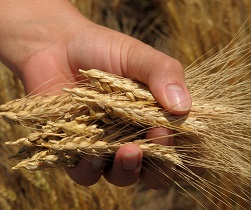Last summer, I vacationed at a retreat in Colorado where just about everyone was on a wheat and gluten-free diet. In fact, the retreat staff where I was staying had just read one of the latest diet books that proclaimed gluten as the new dietary villain, and they were all enthusiastically sharing their new eating plan with everyone. When the retreat director found out that I was a dietitian, she made sure that I knew there were a number of gluten-free foods on the menu. I was also lectured by the masseuse on how gluten and wheat were bad for us as I was trapped in the massage chair.
So why are people jumping on the gluten-free, wheat-free bandwagon? A number of books and television programs have popularized this diet fad by claiming that wheat is responsible for belly fat, gastrointestinal issues and mental health conditions like Alzheimer’s, depression and ADHD. However, there isn’t enough science to back up the authors’ claims. So, if you are thinking about eating gluten or wheat-free, here are the facts:
Celiac Disease, Wheat Allergy and Wheat Sensitivity/Gluten Intolerance
Wheat isn’t good for everyone. Just less than one percent of people in the United States suffer from an autoimmune condition called celiac disease. Certain protein fragments, (produced during digestion of wheat’s gluten proteins), severely damage the walls of the intestines. In addition, an estimated one-half of one percent of people in the U.S. are allergic to wheat, and unknown number of Americans have a less well-defined condition often characterized as wheat sensitivity or gluten intolerance. The key here is that you should be diagnosed with one of these conditions by your health care provider before eliminating these foods from your diet. People who have beendiagnosed with celiac disease, wheat allergy, or gluten intolerance should avoid eating foods that contain any type of wheat, and may have to avoid barley and rye which also contain gluten.
True celiac disease is wicked, and the diet is not fun to follow. People with it wish they could occasionally eat just one slice of bread but that one slice of bread will ravage their gut. People without the disease may feel better eating gluten free but most likely they are experiencing the “halo” or placebo effect.
Belly Fat
Eating too many calories and not exercising contributes to belly fat, and it’s easy to eat too many refined grains found in pastries, snacks and other processed foods. So instead of eliminating all wheat, choose more whole grains. A recent study found that people who ate at least three servings of whole grains each day including wheat had 10 percent lower belly fat compared to people eating no whole grains.
Your Brain on Wheat
The claims about what effect wheat may have on the brain don’t stand up to scientific scrutiny either. The brain needs carbohydrates for energy, and grain foods are an excellent source. When you don’t eat enough carbohydrates, you will feel tired, unable to focus, irritable and may have headaches, and memory and learning problems.
Gut Health
Followers of these popular diets may say that they feel better when they give up wheat and as mentioned they may be experiencing a “halo” or placebo effect. However, when you eliminate grains from your diet, it’s difficult to get the fiber you need to maintain a healthy gut, immune system and overall health. Fiber helps with maintaining good blood sugar control and good blood cholesterol, and avoiding constipation. Fiber also serves as food for the friendly bacteria that keep your gut healthy.
Bottom Line
If you still want to try a gluten-free or wheat-free diet, look for other whole grains that you can include instead such as brown rice, quinoa, or popcorn. Visit the Whole Grains Council for more ideas and recipes. Keep watching – the research on gluten and related topics continues to examine some fascinating questions. This topic is nowhere near run its course!
Many fads diets are hard to sustain in the long run because they are boring. Avoiding favorite foods may also be difficult when temptations arise as I witnessed at my retreat during an evening banquet. A luscious white flour pound cake with glazed peaches was served for dessert. I chuckled to myself as all the gluten-free dieters could not resist and eating wheat became okay.
For further reading:
The Great Gluten Panic: Risk assessments and facts:https://webapp.agron.ksu.edu/agr_social/eu_article.throck?article_id=173
The Gluten-Free Choice:http://www2.ca.uky.edu/agc/pubs/FCS3/FCS3564/FCS3564.pdf
Healthful Whole Grains: http://www.ksre.ksu.edu/bookstore/pubs/mf2560.pdf
In Focus: Gluten-Free: http://www.wheatfoods.org/channels/in-focus
Written by:

Lisa J. Martin, MPH, RD, LD
County Extension Agent-Expanded Food and Nutrition Education Program
K-State Research and Extension-Shawnee County
For more than 15 years, Lisa has enjoyed teaching Shawnee County adults and youth healthful eating on a budget. Her areas of expertise include: nutrition, infant feeding, maternal and child health, menu planning, food budgeting, food safety, healthful meals in minutes, weight management, and hunger and food security.
Reviewed by:
Dr. Sandy Procter, PhD, RD, LD
Extension Specialist, Kansas EFNEP and FNP Coordinator
Department of Human Nutrition
Karen Blakeslee, MS
Coordinator-Rapid Response Center
Kansas State University


